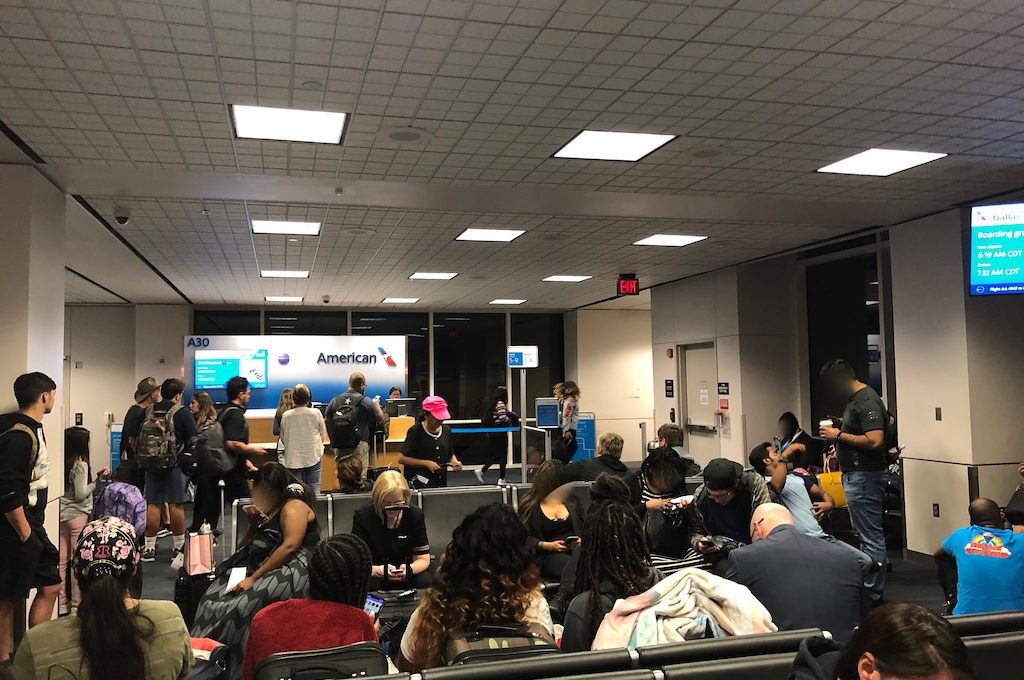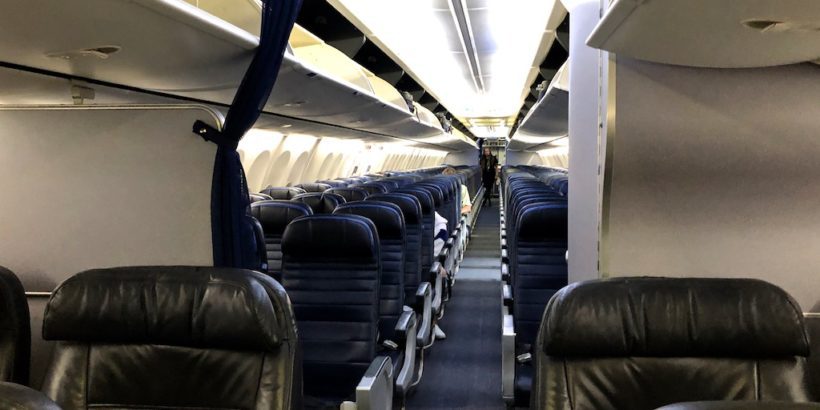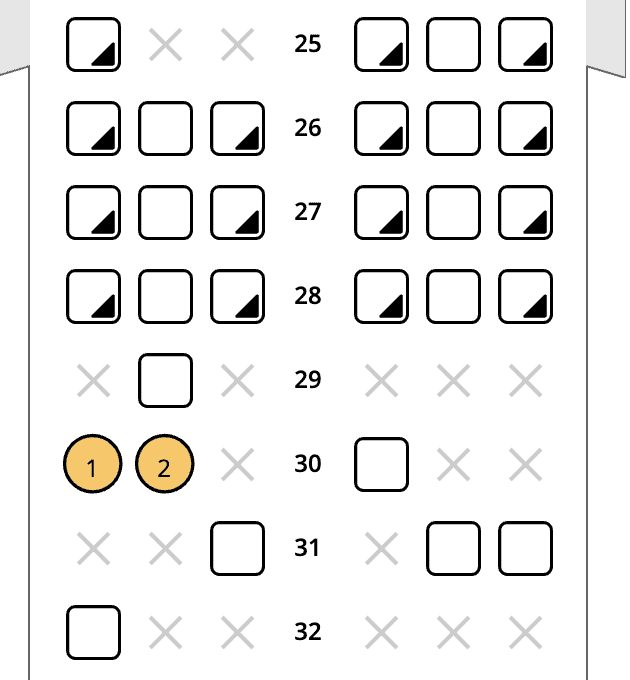Knowing if your flight is going to be full can be very helpful for people who have special requests or are just curious as to what to expect on the flight.
The problem is airlines don’t like to divulge this information so sometimes you have to go about getting it in roundabout ways using “circumstantial evidence” to help you guesstimate how full the flight is.
Below, I will give you several different methods you can try out to help figure out how full your plane is.
Some are more helpful than others but by giving each of these a try, you can often make an educated guess on how full your flight is going to be.
Table of Contents
1. Ask the check-in or gate agent
Whenever you arrive at the check-in desk or at the gate, you can ask an airline employee if your flight is going to be full.
The trick to doing this is to make sure that you clarify that you want to know if there will be any open seats.
That’s important because a lot of times an agent will announce that the “flight is full today” but when they say that they really mean something like 95% full. In other words, there still will be some open seats.
(They sometimes do that to “scare” people into gate checking their carry-on bags so that the boarding process will be smoother.)
In some cases, an agent might be able to tell you exactly how many seats are still available but in other cases it might be more of an estimate.
Just keep in mind that the seat inventory of your flight can change very close to the time of departure if other flight changes and cancellations occur. So if you check with the agent at the gate 30 minutes prior to departure, it’s very possible that things could change in the next 20 minutes.

2. Call the airline
If you want to check on the flight status before you arrive at the airport or even when you are at the airport, you can also call the airline, give them your booking reference number, and see if they can give you information about how full the flight is.
Sometimes you might want to throw in some additional context like you’re concerned about sitting next to other passengers for some type of medical reason or whatever. That’s because it might motivate the agent to be a little bit more diligent.
If you sense the agent is not being helpful or is just being flat out lazy, consider calling back and speaking with another agent who might be more willing to assist.
They may not be able to tell you down to the exact passenger number how filled the cabin is but they should be able to give you an estimate.
For example, whenever I called United Airlines and inquired about a flight itinerary with two segments, the agent was able to look into both flights and tell me that the flights were about “20 something percent” full.
This is an easy way to verify if the flight is full but because things can change so quickly it’s not the most helpful way to know for sure that there will be open seats unless you are calling just before departure time.
3. Check upgrade and standby lists
Some airlines publicly display upgrade and standby lists on their app or website, giving you a real-time peek at how many seats are still available—particularly in premium cabins. This can serve as indirect insight into how full a flight is.
For example:
- Delta is one of the best in this regard. Their app and airport monitors show how many passengers are waiting for upgrades to First Class and Comfort+, and whether seats are still open in those cabins.
- United also shows the upgrade and standby list in their app. If the list is long and most names remain unassigned close to boarding, it may suggest the flight is close to or fully booked.
- American Airlines provides upgrade/standby lists via their app and website as well. You can even see where you stand on the list if you’re waitlisted.
These lists are typically updated within 24 hours of departure—especially after check-in opens—and are most helpful within the last few hours before boarding. They won’t provide useful information days or weeks in advance.
How to Use These Lists:
- If the standby list has lots of names and no seats have cleared close to boarding time, it’s safe to assume the flight is full or overbooked.
- If the upgrade list is long but there are no available First or Business Class seats, it’s a sign that most of those cabins are fully booked.
- If multiple people are waitlisted for upgrades or standby, it likely means coach is also near capacity, since upgrades only occur if there’s space up front and people are moved up from economy.
Related: Why You Should (And Shouldn’t) Check in Online for Flights
4. Attempt a large booking
One quick and surprisingly effective way to estimate how full a flight is? Try booking a large number of seats.
For example, if you’re wondering whether there are at least five available seats, go through the airline’s website or app and start a mock booking for five passengers. If the system allows you to proceed and select seats for all passengers, that’s a good sign those seats are available in the same fare class.
However, if you get an error or a message like “Not enough seats available at this fare”, that usually means fewer than five seats remain in that particular fare bucket. The system might automatically jump to a higher fare or split the booking into multiple transactions.
A few things to keep in mind:
- Try adjusting the passenger count: If five won’t go through, try four, then three, etc., to narrow down how many seats remain.
- Check fare jumps: If the price increases suddenly as you add more passengers, it can mean lower-fare seats have sold out and the system is pulling from a more expensive fare bucket.
- Do this on incognito/private mode: Some believe airline sites use cookies to adjust pricing based on behavior. While this is debated, using incognito mode avoids possible personalized pricing or caching.
Important: This method gives only a rough estimate. Airlines often oversell flights and hold back seats until final check-in, so it doesn’t guarantee the number of physically available seats—only the number of seats open at that fare level.
5. Check the fare buckets
Checking fare buckets—also called booking classes or inventory classes—can give you a rough sense of how many seats are available on a flight. This method is more advanced and often used by frequent flyers, travel agents, and award travelers.
Each ticket sold by an airline falls into a fare class, represented by a letter like:
- F (First)
- J (Business)
- Y (Full-fare Economy)
- Q, G, L, N, etc. (Discounted Economy)
The number next to each letter (like J3 or Y6) refers to the number of seats available in that fare class. So:
- J3 means 3 seats available at the “J” fare (typically a full-fare business class seat).
- Y9 means at least 9 seats available at the full-fare economy level. In fact, 9 is the highest number airlines typically display, even if more seats are available, to obscure inventory data from competitors.
Key things to know:
- Fare buckets do not equal total available seats. If you see Y6 and G4, that doesn’t mean there are 10 economy seats total. There may be some overlap between fare buckets, or fewer physical seats than the combined total.
- Buckets are hierarchical. Y is often the most expensive and flexible fare in economy, while buckets like G or L represent cheaper, more restricted fares.
- Fare bucket counts drop as seats are booked. If you track fare inventory using tools like ExpertFlyer or ITA Matrix, you’ll see those numbers change as people book or cancel.
- Seats can be held or blocked. Airlines often hold seats for elite upgrades, families, or late bookings, which might not be reflected in fare availability.
- Airlines oversell. A bucket may show 4 seats left, but if the plane is technically already full, some passengers may be bumped or rerouted.
Real-world example:
You might see:
- Y9 M5 B2 H0 Q0
This means: - 9+ seats available at full-fare economy (Y)
- 5 seats at a discounted flexible fare (M)
- 2 more deeply discounted fares (B)
- None left in even cheaper fare classes (H, Q)
So even though 9 seats show under “Y”, the total number of available seats could be fewer than 9—it just means there are at least 9 bookable at that price level.
Using ExpertFlyer or AwardNexus, you can monitor fare bucket changes over time. This is especially helpful if you’re:
- Upgrading via miles or elite status (upgrade-eligible fare buckets can signal if an upgrade is likely).
- Trying to book award travel (many programs rely on specific fare buckets for redemption).
- Hoping for a last-minute fare drop (as cheaper fare classes re-open).
6. Check the seat map
Another way to check on how filled the flight is going to be is to check the seat map.
Finding a seat map is usually pretty easy. You simply act like you are going through the booking process on an airline’s website, and you should be able to access the seat map at some point.
Seat maps can be notoriously unreliable though.
That’s because they don’t always accurately reflect which seats are taken. Many people do not choose their seat or get assigned their seat until close to check-in. So seats will remain open even though someone will be filling it.
It would not be uncommon to see dozens of open seats a couple of days before the flight only to find that almost all those seats are taken up once the majority of passengers have checked in.
Sometimes agents will shuffle around passengers who have special requests. For example, a family might ask to be seated together. Those type of requests mean that an empty seat next to you could become occupied at the last minute.
So while the seat maps can help give you an idea of capacity they often are not the best way to predict how full your flight is going to be until you are very close to departure.
Related: How Much It Costs to Choose Your Seats on Each Airline
7. Talk to flight attendants
Another good method is to speak to a flight attendant as you are boarding the flight. Once again, make sure you clarify that you want to know if the flight is 100% full.
If you have a particular needs such as wanting to sit with your child you could voice those to a flight attendant and they may be able to help you spot available seats. Just remember that they have a job to do so if they can’t tend to your requests, be understanding.
Related: Switching Seats on a Plane? Etiquette Tips for Getting “Yes” and Saying “No”
8. Check the news
What does the news have to do with how full your flight is?
If you’ve seen a lot of articles popping up about flight cancellations and delays, perhaps due to bad weather or to ongoing strikes, shortages, etc., there’s a good chance that flights will be fuller than usual.
This is even the case if the cancellations are happening at another airport.
That’s because such circumstances could cause connecting flights to be re-routed. If those flights are re-routed to where you are departing from, all of the empty seats on your flight could easily be filled.
And if you happen to find out that a prior flight from your departure city to your destination has been canceled, you can usually assume that your flight will be full.
This is one of the benefits of booking a super early flight. There are fewer opportunities for other cancellations and changes to cause your flight to fill up.
Final word
In the end, it’s often difficult to know if your flight will be full until you get very close to departure. That’s because many different variables can dictate if your flight will fill up and you can’t always predict those. But if your flight is going to be full days or weeks outside of departure, these methods can help you figure that out.
Daniel Gillaspia is the Founder of UponArriving.com and the credit card app, WalletFlo. He is a former attorney turned travel expert covering destinations along with TSA, airline, and hotel policies. Since 2014, his content has been featured in publications such as National Geographic, Smithsonian Magazine, and CNBC. Read my bio.



You missed the only accurate way to check the number of open seats: the StaffTraveler app!
Unless there’s a reason to really dig in to exact numbers or percentages the seat map can give you a pretty good idea with little effort.